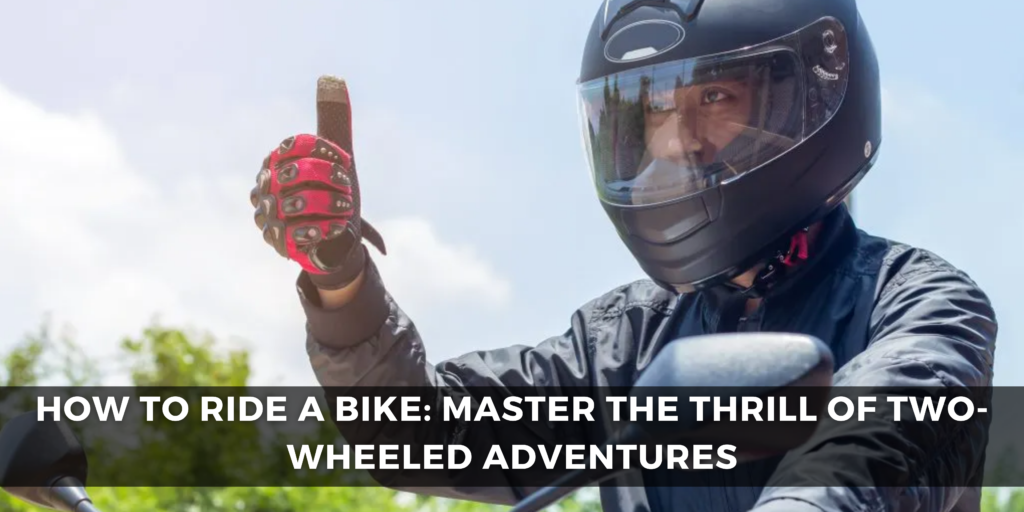
Introduction To Ride a Bike
Welcome to the thrilling world of motorbike riding! Whether you’re a newbie eager to learn or an experienced rider looking to brush up on your skills, this comprehensive guide will walk you through the essentials of mastering the art of Ride a Bike. We’ve got you covered, from the basics of balance to advanced riding techniques. So, let’s rev up those engines and dive into the exciting world of two-wheeled adventures.
Gearing Up
Before you hit the open road, it’s essential to gear up for safety and comfort. Here’s what you need:
- Helmet: Your helmet is your most crucial protective gear. Ensure it’s DOT or ECE-certified for maximum safety.
- Riding Jacket and Pants: Invest in sturdy, abrasion-resistant riding gear. A Motorcycle jacket, often made of leather or textile, is your second line of defense, protecting you from road rash and impact. Look for CE-rated shoulder, elbows, and back armor for added security.
- Gloves: Riding gloves offer grip and protection. Leather or textile gloves with knuckle armor are a great choice.
- Boots: Sturdy, over-the-ankle riding boots provide protection and support.
The Basics of Balance
Mastering balance is the foundation of Ride a Bike. Follow these steps to get started:
- Mounting the Bike: Stand on the left side of the bike, hold onto the handlebars, and swing your right leg over the seat.
- Both Feet on the Ground: Ensure your feet can touch the ground when seated.
- Center of Gravity: Keep the bike’s center of gravity low by balancing it between your legs. Use your core muscles to support the weight.
- Balancing at Low Speeds: Practice balancing by walking the bike or at a slow, controlled pace in a safe, open area.
Basic Motorcycle Controls
Understanding your bike’s controls is crucial. Here’s what you need to know before Ride a Bike:
- Throttle: The right grip controls the throttle. Gently twist it to accelerate and release to slow down.
- Brakes: The right lever operates the front brake, while the right foot pedal controls the rear brake.
- Clutch: The left lever operates the clutch, which you’ll use for shifting gears.
- Shift Lever: Use your left foot to shift gears by moving the lever up or down.
Starting and Stopping
Now, let’s get the bike moving:
- Starting the Engine: Insert the key, turn it to the “on” position, and use the starter button. Keep the bike in neutral (N) if it’s not already.
- Clutch Control: Pull the clutch lever, select first gear (down), and gently release the clutch while adding a bit of throttle.
- Take Off: Gradually release the clutch and apply the throttle to start moving.
- Stopping safely is equally important:
- Braking: Squeeze both brakes evenly to slow down. The front brake provides most of your stopping power.
- Downshifting: As you slow down, downshift to match your speed and maintain engine braking control.
Shifting Gears
Shifting gears is all about maintaining the right balance of power and control:
- Clutch Control: Pull in the clutch lever when you’re ready to shift.
- Shift Up: Gently tap the gear lever with your left foot to shift to a higher gear.
- Downshifting: Similarly, press the lever down to downshift when slowing down or coming to a stop.
Turning and Steering
Now, let’s tackle the art of turning and steering:
- Countersteering: At higher speeds, gently push the handlebar on the side you want to turn. It initiates countersteering, which helps you lean into the turn.
- Leaning: As you countersteer, shift your body weight and lean into the turn. Keep your eyes on the path you want to follow.
Balance in Turns: Maintain a smooth throttle control and even pressure on the handlebars while turning.
Practice and Safety
The key to becoming a skilled rider is practice and safety:
- Practice, Practice, Practice: Find an empty parking lot or a quiet road to practice your skills. Work on slow-speed maneuvers, emergency stops, and sharp turns.
- Continuous Learning: Consider taking a motorcycle safety course to refine your skills and gain valuable knowledge from experienced riders.
- Safety First: Always ride with the proper safety gear, obey traffic laws, and be aware of road conditions and other drivers.
Conclusion to Ride a Bike
Ride a Bike is more than just transportation; it’s a thrilling adventure that offers freedom and excitement. With the right gear, a solid understanding of the basics, and plenty of practice, you’ll be well on your way to mastering the art of motorcycle riding. Safety should always be your top priority, so gear up, stay alert, and enjoy the ride. Welcome to the world of two-wheeled adventures!

